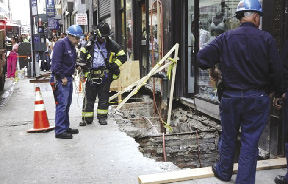Property owners or managers who have occupied space under a pedestrian sidewalk would do well to cast a critical eye on these areas.
These rooms, commonly called sidewalk vaults, can quickly become a headache due to leakage or a full blown disaster in the event of a collapse.
In nineteenth century construction these rooms were often constructed to serve as coal bins that could be filled by a chute from the coal delivery wagon. Common practice, at the time, was to put small glass lenses in an iron frame to provide daylight so that the content could be checked without open flame from lanterns, or later from electrical sparks.
More recent construction used the concept to maximize square footage in a given building footprint.
Waterproofing techniques from these periods were remarkably effective, but nothing lasts forever. Modern materials and methods can provide lasting protection to the structure and peace of mind to owners and managers.
Special consideration should be given to sidewalk vaults which are directly adjacent to roads, fire lanes and parking spaces. If motor vehicles jump the curb onto these structures, they can be subjected to loads they were not designed to carry.
We at CCI, Inc. believe that "An ounce of prevention is worth a pound of cure."
Periodic visual inspections of these areas should be a routine part of your maintenance program. If water penetration, masonry stress cracks or exfoliating steel (rust flakes) is observed, be proactive and call a professional.
The most common threat to these structures, however, is water. Persistent leakage can corrode structural steel to a condition requiring expensive repairs at best, or catastrophic failure at worst. Water splashed onto these structures from roadways, along with wintertime salt and sand, can accelerate the structural steel corrosion and prematurely decay the concrete.
Early detection of these conditions can prevent staggering repair costs. Try to avoid procrastination in performing these relatively minor initial repairs because the basement area is out of public view and thus easier to ignore. Decay can accelerate rapidly to create unsafe, and in the event of mold growth, unhealthy conditions.
If it becomes necessary to rebuild the sidewalk vault there are a few points to consider:
* This is a common problem in major cities and the permit process can be lengthy and complicated.
* Stamped plans from a state certified structural engineer will almost certainly be required.
* If the space under the sidewalk has limited value, consider eliminating it altogether.
CCI recently completed a job in downtown Boston in which the customer felt the basement space under the sidewalk was unused and unmarketable.
We devised a plan to pour a reinforced concrete foundation wall between interior columns, fill between the inner and outer wall with flowable fill and pour the sidewalk as a slab on grade.
This approach resulted in a cost savings of 60% as opposed to a complete rebuild and the city was more than willing to endorse this method because it eliminates the chance of a future reoccurrence.
Dan Simonse is chief estimator at CCI, Inc., North Hampton, N.H.
Tags:
Property owners /managers who have space under a sidewalk should cast a critical eye on these areas
August 04, 2009 - Owners Developers & Managers
 (1).png)









